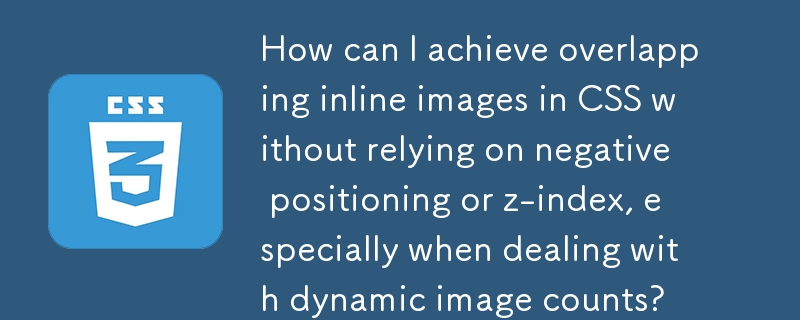 Web Front-end
Web Front-end
 CSS Tutorial
CSS Tutorial
 How can I achieve overlapping inline images in CSS without relying on negative positioning or z-index, especially when dealing with dynamic image counts?
How can I achieve overlapping inline images in CSS without relying on negative positioning or z-index, especially when dealing with dynamic image counts?
How can I achieve overlapping inline images in CSS without relying on negative positioning or z-index, especially when dealing with dynamic image counts?

Overlapping Inline Images: A CSS Solution
Achieving overlapping inline images can be a challenge, but it's possible with careful CSS manipulation. In this article, we'll explore a solution that utilizes flexbox and reverse order to create an effect similar to the provided image.
The Issue
The original code uses negative positioning and z-index to overlap images, but these methods have limitations when it comes to dynamic image counts. Other options, such as combining images externally or using a set width container, introduce their own drawbacks.
The Solution
To avoid these difficulties, you can leverage flexbox and reverse the order of the images. The following CSS code demonstrates this approach:
<code class="css">.avatars {
display: inline-flex;
flex-direction: row-reverse;
}
.avatar {
position: relative;
border: 4px solid #fff;
border-radius: 50%;
overflow: hidden;
width: 100px;
}
.avatar:not(:last-child) {
margin-left: -60px;
}
.avatar img {
width: 100%;
display: block;
}</code>Explanation
- Flex Direction: We set the flex-direction to row-reverse to reverse the order of the images, with the last image appearing on the far left.
- Negative Margin: To create an overlap effect, we apply a negative margin to all images except the last one. The amount of margin is adjustable based on the desired overlap.
- Border: A white solid border is added around each image to visually separate them.
HTML Structure
Along with the provided CSS styles, adjust your HTML as follows:
<code class="html"><div class="avatars">
<span class="avatar">
<img src="image1.jpg">
</span>
<span class="avatar">
<img src="image2.jpg">
</span>
<span class="avatar">
<img src="image3.jpg">
</span>
</div></code>This code will produce a row of overlapping inline images without requiring complex calculations or external image manipulation. The effect is fully dynamic and adapts to any number of images.
The above is the detailed content of How can I achieve overlapping inline images in CSS without relying on negative positioning or z-index, especially when dealing with dynamic image counts?. For more information, please follow other related articles on the PHP Chinese website!

Hot AI Tools

Undresser.AI Undress
AI-powered app for creating realistic nude photos

AI Clothes Remover
Online AI tool for removing clothes from photos.

Undress AI Tool
Undress images for free

Clothoff.io
AI clothes remover

Video Face Swap
Swap faces in any video effortlessly with our completely free AI face swap tool!

Hot Article

Hot Tools

Notepad++7.3.1
Easy-to-use and free code editor

SublimeText3 Chinese version
Chinese version, very easy to use

Zend Studio 13.0.1
Powerful PHP integrated development environment

Dreamweaver CS6
Visual web development tools

SublimeText3 Mac version
God-level code editing software (SublimeText3)

Hot Topics
 Vue 3
Apr 02, 2025 pm 06:32 PM
Vue 3
Apr 02, 2025 pm 06:32 PM
It's out! Congrats to the Vue team for getting it done, I know it was a massive effort and a long time coming. All new docs, as well.
 A bit on ci/cd
Apr 02, 2025 pm 06:21 PM
A bit on ci/cd
Apr 02, 2025 pm 06:21 PM
I'd say "website" fits better than "mobile app" but I like this framing from Max Lynch:
 Can you get valid CSS property values from the browser?
Apr 02, 2025 pm 06:17 PM
Can you get valid CSS property values from the browser?
Apr 02, 2025 pm 06:17 PM
I had someone write in with this very legit question. Lea just blogged about how you can get valid CSS properties themselves from the browser. That's like this.
 Stacked Cards with Sticky Positioning and a Dash of Sass
Apr 03, 2025 am 10:30 AM
Stacked Cards with Sticky Positioning and a Dash of Sass
Apr 03, 2025 am 10:30 AM
The other day, I spotted this particularly lovely bit from Corey Ginnivan’s website where a collection of cards stack on top of one another as you scroll.
 Using Markdown and Localization in the WordPress Block Editor
Apr 02, 2025 am 04:27 AM
Using Markdown and Localization in the WordPress Block Editor
Apr 02, 2025 am 04:27 AM
If we need to show documentation to the user directly in the WordPress editor, what is the best way to do it?
 Comparing Browsers for Responsive Design
Apr 02, 2025 pm 06:25 PM
Comparing Browsers for Responsive Design
Apr 02, 2025 pm 06:25 PM
There are a number of these desktop apps where the goal is showing your site at different dimensions all at the same time. So you can, for example, be writing
 Why are the purple slashed areas in the Flex layout mistakenly considered 'overflow space'?
Apr 05, 2025 pm 05:51 PM
Why are the purple slashed areas in the Flex layout mistakenly considered 'overflow space'?
Apr 05, 2025 pm 05:51 PM
Questions about purple slash areas in Flex layouts When using Flex layouts, you may encounter some confusing phenomena, such as in the developer tools (d...
 How to Use CSS Grid for Sticky Headers and Footers
Apr 02, 2025 pm 06:29 PM
How to Use CSS Grid for Sticky Headers and Footers
Apr 02, 2025 pm 06:29 PM
CSS Grid is a collection of properties designed to make layout easier than it’s ever been. Like anything, there's a bit of a learning curve, but Grid is





